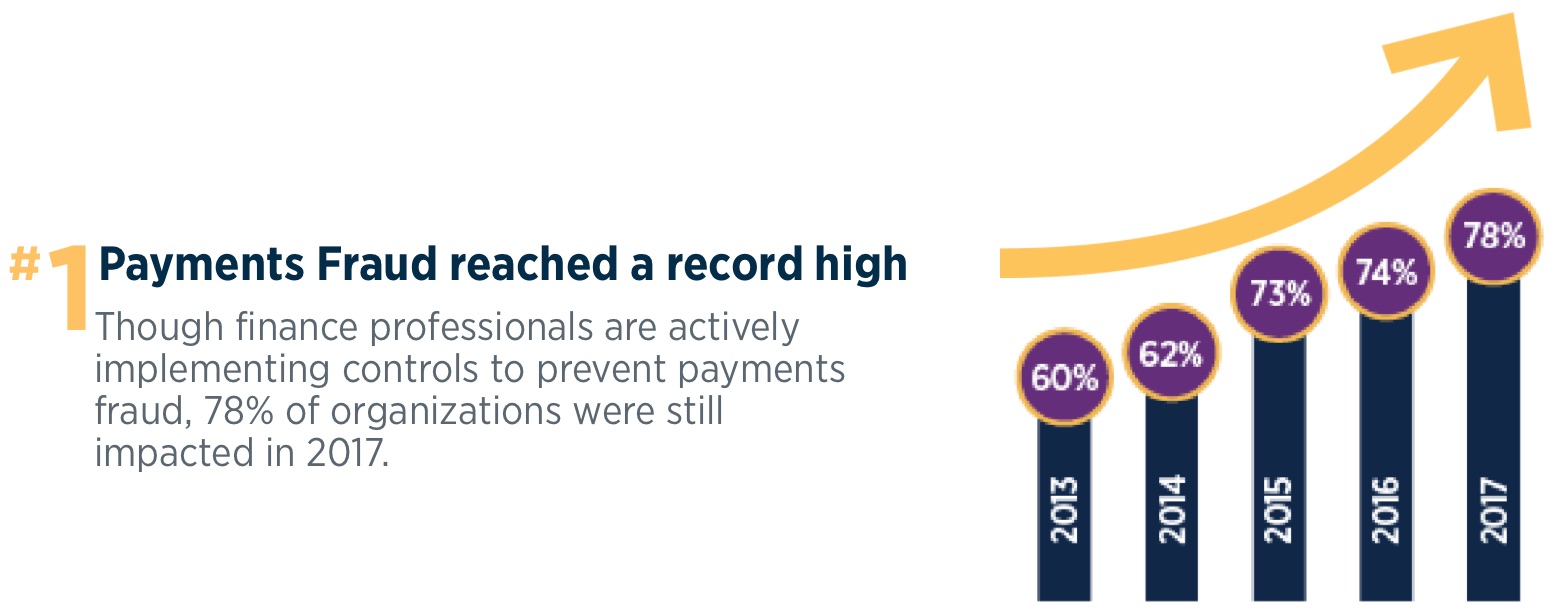Corporate Clients See Payments Fraud on the Upswing, Says AFP: Modernization Needed
The 2018 AFP Payments Fraud Survey, underwritten by J.P. Morgan, has some alarming fraud news for corporate clients and the treasury departments of financial institutions. Overall payments fraud reached a new peak in 2017, after experiencing a downswing earlier in the decade. A record 78% of all organizations were hit by payments fraud last year, according to the survey of nearly 700 treasury and finance professionals.

AFP Graphic
Checks continue to be the subject of more fraud than any other payment method in the survey, with 74% of respondents reporting this form of attack. Wire fraud followed at 48%, while corporate card fraud ranked third at 30%. Here is an example of a common use case:
- Use case #1: “Recently someone was issuing checks to individuals for work done over the internet. The checks were forged from one of our disbursement accounts.”
- Solution #1: “They were all caught with Positive Pay and returned.”
However, many times, fraudsters take a blended approach!
- Use case #2: “We discovered counterfeit checks and ACH debit fraud on an account that did not have Positive Payee feature or ACH debit block because of the urgency to open account.”
- Solution #2: “We added the necessary filters and notified the bank of the fraudulent activities. I cannot stress enough the importance of Positive Payee.”
Business email compromise (BEC) played a major role in payments fraud in 2017, with 77% of organizations experiencing BEC in 2017. Additionally, 54% of BEC scams targeted wires, followed by checks at 34%. The good news is that 77% of organizations have implemented controls to prevent BEC scams.
“It is alarming that the rate of payments fraud has reached a record high despite repeated warnings,” said AFP President and CEO Jim Kaitz. “In addition to being extremely vigilant, treasury and finance professionals will need to anticipate scams and be prepared to deter these attacks.”
Related to corporate remote deposit capture (RDC), it’s been running under the radar. However, many banks are now expanding their deposit limits, so there will be incremental risk in the future. Mobile RDC is now expanding into the small business arena as well. This category of deposit would ideally see advanced validation approaches on these transactions.
Think about check fraud in today’s market — not as a negative, but as an opportunity. Why? Checks are healthy, (against the predictions of pundits) and there are ebbs and flows in fraudster behavior. This could be a by-product of the EMV protections implemented for credit cards over the past two years.
Now is the time to modernize features on the corporate check image side. There are several essentials: Positive Pay, Positive Pay with Payee Name Verification, or minimally Payee Verification. Additionally, banks and corporate customers have not implemented image analysis features like Automated Signature Verification and Check Stock Validation aggressively.
Many banks are evaluating ways to modernize fraud prevention for corporate clients and retail accounts as well. Fraud vendors and financial institutions need to get serious on how to implement significant improvements with image analysis and recognition to further protect the check.